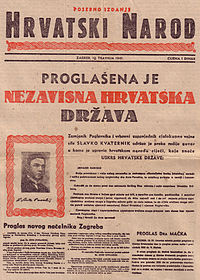Hrvatski Narod
| Hrvatski Narod | |
|---|---|

|
|
| description | Croatian weekly or daily newspaper |
| language | Croatian |
| Headquarters | Zagreb |
| First edition | February 9, 1939 |
| attitude | March 1, 1940 or 1945 |
| founder | Mile Budak |
| Frequency of publication | 1939–1940: once a week 1941–1945: twice a day |
| Widespread edition | from 1941: 50,000 copies |
| Editors-in-chief | Ivan Oršanić (political) |
| editor | Mile Budak |
Hrvatski Narod (Croatian People) was a newspaper in the Kingdom of Yugoslavia and later in the Independent State of Croatia (NDH) and the journalistic organ of the fascist Ustasha .
Hrvatski Narod was founded as a weekly newspaper by Mile Budak in 1939 and appeared after prior state censorship . Numerous anti-Semitic articles have been published. So are Jews were aliens, which the Croatian people had exploited. In March 1940, the Croatian government banned the newspaper .
After the German attack on Yugoslavia , the subsequent takeover of power by the Ustascha and the establishment of the Independent State of Croatia on April 10, 1941, the newspaper was distributed again and served as the Croatian equivalent of the Völkischer Beobachter . The most important Yugoslav journalists willing to collaborate gathered around Hrvatski Narod and the Serbian daily Novo Vreme in Belgrade . The Ustaša Commissioner for Newspapers took over the most important press companies and institutions in Zagreb on the day of the seizure of power and organized a press office to head the newspaper system for the next few months. The daily newspapers Jutarnji List , Večer and Obzor of the Tipografija dd concern were banned partly because of their earlier attitude and partly because of their Jewish owners. The group was nationalized, the entire administration, printing, equipment and part of the editorial offices of the three newspapers for the Hrvatski Narod . From 1941 onwards, the newspaper appeared as a daily newspaper in the evening and morning and developed into the state's leading daily newspaper with a circulation of at least 50,000 copies. Between 1941 and 1943 Alfons Dalma was one of the editors of the Hrvatski Narod and between 1943 and 1945 essays by the Germanist Gustav Šamšalović were published.
Hrvatski Narod was the main journalistic organ of the Ustascha government and served to glorify the new state, Croatianity, the Ustascha and the reorganization of Europe by Adolf Hitler . The first three pages were devoted to the military and economic achievements of Nazi Germany and Croatia's contribution to it. The newspaper ran open agitation against Croatian Jews and anti-Jewish propaganda. The aim was to justify the Ustasha's anti-Semitic measures by defaming Jews as threats or traitors.
Individual evidence
- ^ A b Sabrina P. Ramet : Personalities in the History of the NDH . In: Totalitarian Movements and Political Religions . tape 7 , no. 4 , 2006, ISSN 1469-0764 , p. 493-498, here p. 493 , doi : 10.1080 / 14690760600963255 .
- ↑ Miroslav Krleža (ed.): Enciklopedija Jugoslavije . tape 5 : Hrv - Janj. Jugoslavenski Leksikografski Zavod "Miroslav Krleža", 1988, ISBN 978-86-7053-013-3 , p. 409 : “Diktatura 1929. nanijela je konačan udarac stranačkom tisku; gotovo je sav zabranjen. Uvođenjem oštre prethodne cenzure po novim odredbama zakona o tisku bitno se suzuje i relativna sloboda koju je do 1929. uživao informativni tisak. "
- ↑ a b c d e Wolfgang Benz (Ed.): Handbook of Antisemitism . Hostility to Jews in the past and present. Volume 6: Publications. de Gruyter Saur, Berlin a. a. 2013, ISBN 978-3-11-025872-1 , p. 285.
- ^ A b Anna Maria Grünstelder: Work commitment for the reorganization of Europe. Civil and forced laborers from Yugoslavia in the "Ostmark" 1938 / 41–1945 . Böhlau, Vienna a. a. 2010, ISBN 978-3-205-78453-1 , pp. 28 .
- ^ American Jewish Committee. Research Institute on Peace and Post-War Problems (Ed.): The Jewish communities of Nazi-occupied Europe . H. Ready, 1982, ISBN 978-0-86527-337-5 , pp. 18 .
- ↑ Ladislaus Hory, Martin Broszat : The Croatian Ustasha state. 1941–1945 (= series of the quarterly books for contemporary history . 8, ISSN 0506-9408 ). Deutsche Verlags-Anstalt, Stuttgart 1964, p. 81 f.